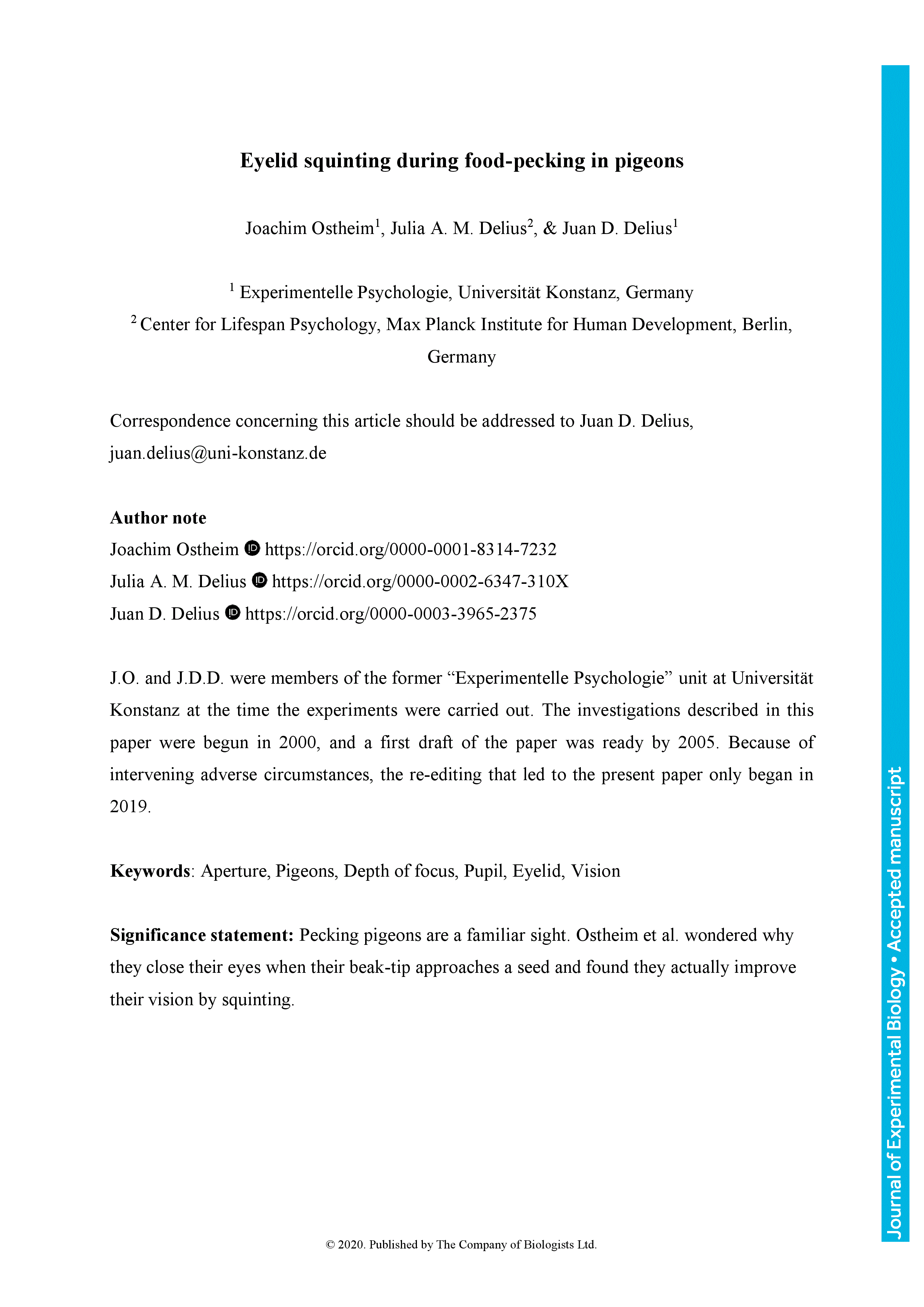The visual control of pecking by pigeons (Columba livia) has latterly been thought to be restricted to the fixation stops interrupting their downward head movements because these stops prevent interference by motion blur. Pigeons were also assumed to close their eyes during the final head thrust of the peck. Here we re-examine their pecking motions using high-speed video recordings and supplementary provisions that permitted a three-dimensional spatial analysis of the movement, including measurements of their pupil diameters and eyelid slit width. The results confirm that pigeons do not close their eyes completely during the presumed optically ballistic phase of pecking. Instead their eyelids are narrowed to a slit. The width of this slit is sensitive to both the ambient illumination levels and the visual backgrounds against which seed targets have to be detected and grasped. There is also evidence of some interaction between pupil diameter and eyelid slit width. We surmise that besides being an eye-protecting reflex, the partial covering of the pupil with the eyelids may increase the depth of focus, enabling pigeons to obtain sharp retinal images of peck target items at very close range and during the beak-gape ‘handling’ of food items and occasional grit particles.
Eyelid squinting during food-pecking in pigeons
J.O. and J.D.D. were members of the former “Experimentelle Psychologie” unit at Universität Konstanz at the time the experiments were carried out. The investigations described in this paper were begun in 2000, and a first draft of the paper was ready by 2005. Because of intervening adverse circumstances, the re-editing that led to the present paper only began in 2019.
Currently Viewing Accepted Manuscript - Newer Version Available
- Split-screen
- Views Icon Views
- Open the PDF for in another window
-
Article Versions Icon
Versions
- Version of Record 04 June 2020
- Accepted Manuscript 01 January 2020
- Share Icon Share
-
Tools Icon
Tools
- Search Site
Joachim Ostheim, Julia A. M. Delius, Juan D. Delius; Eyelid squinting during food-pecking in pigeons. J Exp Biol 2020; jeb.223313. doi: https://doi.org/10.1242/jeb.223313
Download citation file:
Advertisement
2023 JEB Outstanding Paper Prize shortlist and winner

The JEB Editors are delighted to announce the shortlisted authors for the 2023 JEB Outstanding Paper Prize. Read the winning paper - Tiny spies: mosquito antennae are sensitive sensors for eavesdropping on frog calls - by Hoover Pantoja-Sanchez and Brian Leavell from Ximena Bernal's lab at Purdue University, USA.
JEB Science Communication Workshop for ECRs

If you’re an early-career researcher interested in science communication and are attending the SEB Annual Conference in Prague this summer, come a day early and join the JEB Editors at a sci comm workshop to learn the key writing skills needed to promote your research to a broad audience beyond your peers (1 July at 14.30-17.30). Places are limited to 24 attendees, and applicants should apply through the SEB registration page by 30 April 2024.
Bridging the gap between controlled conditions and natural habitats in understanding behaviour

Novel technologies enable behavioural experiments with non-model species, in naturalistic habitats and with underexplored behaviours. In their Commentary, Scholz and colleagues discuss how to obtain a deeper understanding of the natural ecology and lifestyle of study animals.
Beluga metabolic measures could help save species

To help save animals from extinction, it’s important to understand what each species needs to survive. This led Jason John et al. to measure the metabolic rates of captive belugas to develop a ‘fish calculator’ showing that the whales need to eat ~23 salmon per day.
ECR Workshop on Positive Peer Review

Are you an ECR looking for tips on how to write concise, astute and useful manuscript reviews? If so, join the JEB Editors at a 2-hour JEB-sponsored Workshop on Positive Peer Review at the Canadian Society of Zoologists annual meeting in Moncton on 9 May 2024 at 13.00-15.00. There are 25 spaces for ECRs and selection is first come, first serve. To sign up, check the ECR Workshop box when you register for the CSZ meeting.



